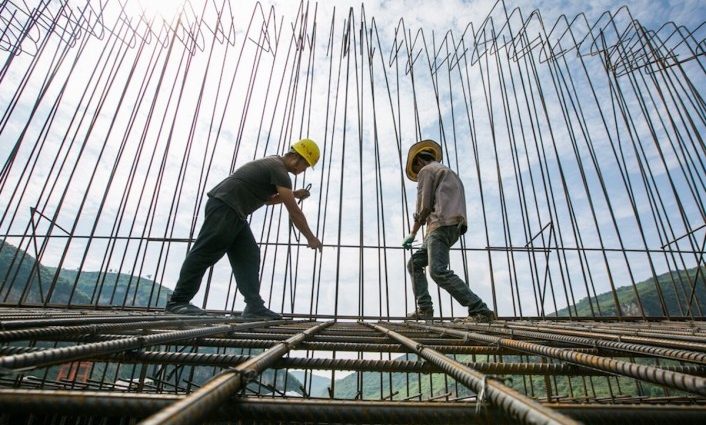On November 11, 2022, the People’s Bank of China and the former Banking and Insurance Regulatory Commission issued a joint notice outlining 16 supporting policies for the real estate sector.
It was aimed at “maintaining orderly and stable real estate financing, improving financial services for building handover, handling risks of distressed real estate companies, and increasing financial support for housing rental.”
China’s overall real estate policy has relaxed since then. On July 10, 2023, the People’s Bank of China and the National Financial Supervision and Administration Bureau issued an additional notice to extend the policy period.
This reaffirms Beijing’s commitment to supporting the “healthy development” of the real estate industry. The extension involves two key points.
Financial institutions were encouraged to support existing real estate loans through loan extensions and adjusted repayments. Loans due before December 31, 2024, could be extended for an additional year without changing their classification.
Loans issued for unfinished projects before December 31, 2024, by commercial banks that adhere to the 2022 Notice will not be downgraded during the loans’ term. For newly issued loans that become non-performing, the institutions and personnel performing their duties can be exempted from liability.
Such persistent policy support for the real estate industry may create moral hazard and hamper the consumption-driven economic development model that Beijing wants. Some posit that the Chinese government still staunchly backs this industry because housing represents more than 70% of urban household wealth.

A decline in housing prices could create negative wealth effects that weaken consumer demand and economic growth. But this is just one facet of the rationale. Major political economy explanations provide a more comprehensive understanding of this quandary.
China’s primary national interest is sustaining economic growth as China aims to become “a medium-level advanced nation” by 2035. China is now in the process of rapid urbanization and industrialization.
The country’s future GDP growth rate is expected to be 4-5% per annum — lower than it has been since the 1990s but still modest. The real estate industry has contributed significantly to China’s ‘economic miracle’, averaging 13.4% of GDP since 2013.
According to a Stanford University report, the sector “has remained around 26% of GDP since 2018” — a high portion by both international and domestic standards. Given the unstable external environment and the challenges of domestic economic transition, higher fixed asset investment and support for the real estate industry appear to be the Chinese government’s most viable options for the near and medium term.
Another explanation for why the government backs the real estate industry so readily is that Chinese local governments rely heavily on revenues generated from selling land to real estate developers. This land sales revenue, combined with real estate taxes, contributes nearly 40% of the government’s income.
This income is used for local economic development, including infrastructure projects. These infrastructure developments attract further investments, stimulate local economies and create jobs, forming a cycle of economic growth. The Chinese government, especially at the local level, has strong incentives to support and stabilize the real estate industry.
But a land sales-focused fiscal system could lead to myopic governmental decision-making. An over-reliance on the real estate sector has already led to an economic imbalance and raised long-term sustainability concerns. Still, as a significant source of fiscal revenue, the real estate sector is favored over other vital sectors.
The real estate industry is also a significant employer. According to the Fourth National Economic Census, the industry directly employed 12.64 million people as of 2018 — a 44% increase from 2013. Considering that the housing construction industry employed 35.91 million workers, the total number of people in real estate-related jobs in 2018 was close to 49 million.
During economic hardship, the role of the real estate industry as a significant employer becomes crucial. China’s unemployment rates in 31 large cities have increased more than 12% since 2018 due to the US-China trade war, the pandemic and domestic deflationary pressure.
Surveyed unemployment rates of workers between 16 and 24 years old have spiked from 11% in early 2018 to roughly 21% in June 2023. Widespread unemployment within the real estate industry could exacerbate economic damage and social problems. So for the Chinese government, a resilient real estate industry is critical for economic and social stability in the foreseeable future.

Despite the Chinese government’s insistence that “houses are for living, not for speculation,” the government continues to support this sector due to its crucial contribution to China’s GDP, fiscal revenue and employment.
While there is a growing consensus that Beijing is unlikely to adhere to the credit-fuelled, debt-laden property development paradigm, it will likely continue propping up the real estate industry to avert systemic perils — given its many stakeholders — in the foreseeable future.
In 2011, I argued that the path of China’s economic transition would be bumpy. The journey remains intricate and protracted. The real estate sector has been instrumental in China’s rapid economic growth, but it presents complex challenges for this transition.
Balancing economic stability, employment preservation and the prevention of speculative bubbles has been – and will continue to be – a delicate task.
Yuhan Zhang is a scholar based at UC Berkeley where he specializes in China’s political economy and an Adjunct Assistant Professor at the G20 Center of Beijing Foreign Studies University’s International Business School.
A version of this article first appeared here in China’s Economy and the World.
This article was originally published by East Asia Forum and is republished under a Creative Commons license.

